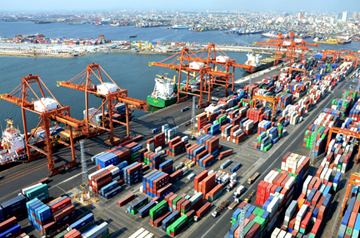Opened 12th Century Type of harbor Natural/Artificial | Owned by Government of Manila | |
 | ||
Operator | ||
Manila philippines legend of the seas at the port of manila hd 2015
The Port of Manila (Filipino: Pantalan ng Maynila) refers to the collective facilities and terminals that processes maritime trade function in harbours that serves the Metro Manila Area. It is located in the Port Area and Tondo area of Manila, Philippines facing the Manila Bay. It is the largest and the premier international shipping gateway to the country. The Philippine Ports Authority, a government-owned corporation, manages the Port of Manila and most of the public ports in the country. It is composed of 3 major facilities namely Manila North Harbor, Manila South Harbor and the Manila International Container Terminal.
Contents
- Manila philippines legend of the seas at the port of manila hd 2015
- Map of North Harbor Tondo Manila Metro Manila Philippines
- Manila philippines bands play at the port of manila for the legend of the seas hd 2015
- History
- Location
- Manila North Harbor
- Manila South Harbor
- Manila International Container Terminal
- Future Plans
- References
Map of North Harbor, Tondo, Manila, Metro Manila, Philippines
Manila philippines bands play at the port of manila for the legend of the seas hd 2015
History
The Port of Manila and the area dates back to Spanish and pre-Spanish rule of the Philippine Islands. It is recorded that Manila and the Philippines had trade relations with most neighboring countries at least as far back as the 9th to 12th centuries. Major trading partners included China and Japan, with ties to India through the areas that are now Malaysia and Indonesia. The Spanish-controlled Port of Manila handled trade primarily with China and other East Asian countries, with Mexico, with Arab countries, and directly with Spain from the 16th to mid-19th century CE when the port was opened to all trade ships. Manila Bay was the setting for the Battle of Manila Bay in 1898 between United States and Spanish forces, and the siege of Corregidor Island by invading Japanese forces in 1942.
Location
The bay entrance is 19 kilometres (12 mi) wide and expands to a width of 48 kilometres (30 mi). Mariveles, in the province of Bataan, is an anchorage just inside the northern entrance, and Sangley Point is the former location of Cavite Naval Base. On either side of the bay are volcanic peaks topped with tropical foliage. 40 kilometres (25 mi) to the north is the Bataan Peninsula and to the south is the province of Cavite.
Manila North Harbor
Manila North Harbor (seaport code:MNN), occupying a 53-hectare area in Tondo, Manila and operated by the Manila North Harbour Port Incorporated, has 7 piers namely Pier 2, 4, 6, 8, 10, 12 and 14. North Harbor is accessible by road through Radial Road 10. Modernization of the port facility involves the acquisition of heavy equipment, dredging operations, information technology, container terminal expansion and a recently completed North Port Passenger Terminal that can accommodate more passengers, boost tourism in the country, and replace the old terminal.
Manila South Harbor
Manila South Harbor (seaport code:MNS), an 80-hectare port facility located in Port Area, Manila and operated by Asian Terminals Incorporated, has 5 piers namely Pier 3, 5, 9, 13 and 15. It is accessible by road through Bonifacio Drive has a passenger terminal located between Pier 13 and 15 namely Eva Macapagal Super Terminal. It also houses as the main hub of 2GO ferry company. As of April 29, 2014, The management has installed a new Liebherr quay crane to increase the efficiency of Manila South Harbor.
Manila International Container Terminal
Manila International Container Terminal (seaport code:MNL) is operated by International Container Terminal Services Inc. It is one of Asia's major seaports and one of the Philippines' most active ports. It is located between the Manila North Harbor and the Manila South Harbor and can be accessed by road through MICT South Access Road. In 2011, Manila International Container Terminal ranked 38th place in the List of world's busiest container ports with container traffic(TEU) of 3,260,000. Inaugurated on July 7, 2012, Berth 6 became fully operational and increases the Port's annual capacity by 450,000 TEU's.
Future Plans
With Berth 6 in operation, ICTSI is scheduled to finish Phase 1 development of Yard 7 by yearend and increase MICT’s import capacity by 18 percent.
South of Metro Manila, ICTSI’s Laguna Gateway Inland Container Terminal (LGICT) has finished its Phase 1 development. The inland container depot (ICD), which serves as an extension of the MICT, adds 250,000 TEUs to MICT’s annual capacity. It will be connected to Manila through the revival of the Manila-Calamba cargo intermodal system, which ceased operations in 2000 due to lower demand.
